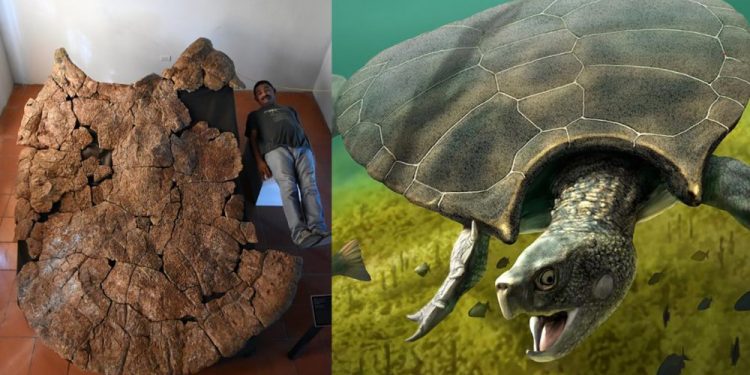A turtle, the size of a car, dubbed Stupendemys Geographicus, is thought to have been the largest turtle ever on the planet’s surface. The recently-uncovered fossils were found in strata that date back around eight million years. New specimens of the extinct turtle “Stupendemys Geographicus,” described in 1970, reveal that it was 100 times heavier than its relatives and had a three-meter, horned shell.
A three-meter carapace
“The carapace of some Stupendemys individuals reached almost three meters, making it one of the largest, if not the largest turtle that ever existed,” says Marcelo Sánchez, director of the Paleontological Institute and Museum of UZH and head of the study. Specimens of the massive turtle were discovered by Paleobiologists from the University of Zurich while exploring Venezuela and Colombia. This region, together with parts of Brazil, is considered a global hot spot regarding animal diversity. The extinct fauna of the region has been described as beyond unique, and evidence of that is some of the fossils discovered in the region, like those of giant rodents and crocodylians.

Estimated mass of 1,145 kg
The discovery of Stupendemys Geographicus is incredible. With an estimated mass of 1,145 kg – almost one hundred times that of its closest living relative, the big-headed Amazon river turtle, Stupendemys Geographicus, was a true giant. The researchers have reported that the shell revealed a peculiar and unexpected characteristic in certain specimens: horns. “The two shell types indicate that two sexes of Stupendemys existed – males with horned shells and females with hornless shells,” explained Sánchez.
Stupendemys Geographicus: The size of a car
The paleobiologist revealed that this is the first time that sexual dimorphism in the form of horned shells has been described for any of the side-necked turtles, one of the two major groups worldwide. Although it was the size of a car, the turtle had natural enemies. The researchers report that the occurrence of Stupendemys in many areas coincides with Purussaurus, the largest caimans. This is supported by the discovery of bite marks and punctured bones in the fossilized carapaces of Stupendemys.
Jaws, but of a different kind
In addition to the carapace of the giant turtle, scientists have also discovered its jaws, among other skeleton parts. This allowed them to thoroughly review the evolutionary relationship of the species within the turtle family tree of life. This led experts to conclude that the turtles living in the Amazon are the closest relatives of Stupendemys Geographicus. “Based on studies of the turtle anatomy, we now know that some living turtles from the Amazon region are the closest living relatives,” Sánchez revealed.
Similar fossils out there
Researchers further explained that based on the findings of similar fossils in Brazil, Colombia, and Venezuela, a much wider geographic distribution of Stupendemys can be inferred; the animal lived across the whole northern part of Southern America.











